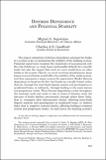Artículo
Distress dependence and financial stability
Fecha
2010Resumen
The proper estimation of distress dependence amongst the banks in a system is key to monitoring the stability of the banking system. Financial supervisors recognize the importance of assessing not only the risk of distress i.e. large losses and possible defaults by a specific bank but also the impact that such an event would have on other banks in the system. Clearly an event involving simultaneous large losses in several banks would affect the stability of the whole system and thus represents a major concern for supervisors. Banks’ distress dependence is based on the fact that banks are usually linked either directly through the inter-bank deposit market and participation in syndicated loans or indirectly through lending to the same sectors and proprietary trades. Their distress dependence varies throughout the economic cycle and tends to rise in times of distress since the fortunes of banks decline concurrently through either direct links that is contagion after idiosyncratic shocks affecting inter-bank deposit markets and participation in syndicated loans or indirect links that is negative systemic shocks affecting lending to common sectors and proprietary trades.
Colecciones
Descargar


